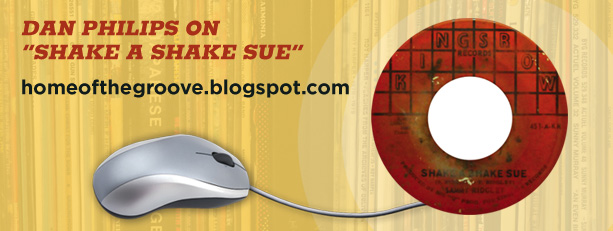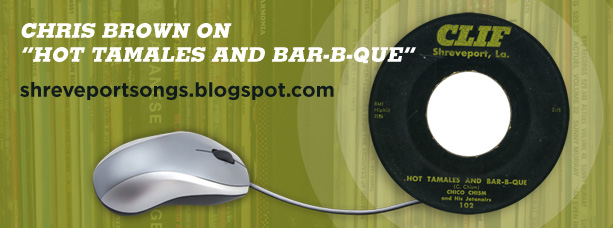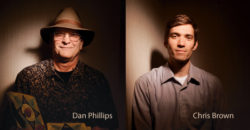Magazine
Rhythm Revealers
Bloggers dig deep to preserve the unsung heroes of Louisiana music
Published: December 15, 2015
Last Updated: April 29, 2019

Photo by Aubrey Edwards
But ask anybody who attended the roots-music festival Ponderosa Stomp in New Orleans in October 2015 and they’ll tell you that the story of rock ’n’ roll is more accurately told by songs and singles. Swamp-pop singers, rockabilly cats, garage bands and countless blues and R&B singers—those are the unsung heroes of rock ’n’ roll, the artists whose hits were often regional more than national. And while Irma Thomas was one of this year’s marquee acts, the talk of the Stomp was the West Side Soul Revue, which brought together musicians who were likely unknown to those who never followed San Antonio’s Latino R&B scene in the 1950s and ’60s.
Dan Phillips and Chris Brown counted the West Side Soul Revue among their highlights of this year’s Stomp. They were part of the packed house of record collectors and self-identified music nerds who showed in numbers that surprised even the organizers this year. Phillips came from Lafayette and Brown from Shreveport, and both write “mp3 blogs” dedicated to Louisiana music. Phillips has been writing about New Orleans funk and R&B on his Home of the Groove blog (homeofthegroove.blogspot.com) since 2004, while Brown began posting on the self-explanatory Shreveport Songs (shreveportsongs.blogspot.com) in 2011. The sites feature digitized records from their personal collections and discussions of the people and sounds immortalized on wax. Like the acts showcased at the Stomp, mp3 blogs tend to be a little obscure as they highlight lesser-known records and overlooked artists. That’s certainly the case at Home of the Groove, according to Phillips.
“I don’t think Fats Domino needs any help, but [New Orleans R&B legend] Earl King—people only know him secondhand or thirdhand from people covering his work,” he says. Brown agrees. Rather than revisiting stories of Elvis Presley on the Louisiana Hayride radio show, “I’d rather start a new conversation,” he says. At Shreveport Songs, he does so by keeping his posts tight—a paragraph or two of text, a historical photo, and a link to the music. His posts don’t analyze the songs as much as let people know they exist. Brown differs from Phillips in the way he documents a city more than a sound. His most recent posts include previously unpublished photos of Hank Williams, an obscure blues instrumental, and radio ads for a local institution, a store formerly operated by Stan “The Record Man” Lewis.
Phillips’ writing, on the other hand, only differs from traditional liner notes in his first-person interjections. Many of his posts from the last year were literally written to accompany playlists from his radio show, but for most of the blog’s run, Phillips examined overlooked records, lesser known careers, and interesting associations, usually at some length. In one post, he told the story of cult figure Swamp Dogg producing Irma Thomas.
Their blogs are the inevitable digital-age manifestation of fandom. People used to turn others on to cool records in someone’s house, in record stores, on mixed cassette tapes, or self-burned CDs. Today, that process takes place online as well, and that sharing is more important to Phillips and Brown than the technological means. The histories they tell are personal, not because Phillips, Brown, or other bloggers cherry pick their facts, but because the songs and artists they write about reflect their values, preferences, knowledge at the time of writing, and intuitive sense of the big picture. They don’t sweat mp3 fidelity either, going with 128 kbps mp3s that reduce files to manageable size, though that leaves the tracks a little lo-fi as a result.
“People don’t care,” Phillips says. “As long as they can hear what it sounds like.” Besides, he says, the cherished sound attributed to vinyl is only found when listening to albums. “Most of the 45s, forget it. The sound quality of 45s has traditionally been atrocious.”
Phillips and Brown came to blogging from radio. Phillips grew up in Memphis, where he did a show on New Orleans music at noncommercial radio station KEVL from 1988 to 2004. For much of that time, he also served as program director, and that became so tiring that when his wife from South Louisiana wanted to go home, he was ready to move. While unemployed and surfing the Net, he ran across Oliver Wang’s Soul Sides blog. When Wang wrote a post telling readers how to start their own mp3 blogs, Phillips created his first few posts for Home of the Groove and shot Wang a note looking for feedback. He liked Home of the Groove enough to add it to his blogroll—the list of blogs that Wang followed or recommended.
“That was like taking off in a rocket ship,” Phillips says. “So many people read his blog that they added my blog to their blogrolls. I still get linked out.” Today Phillips also hosts a New Orleans music show in Lafayette on KRVS.
Shreveport Songs is an extension of Brown’s campus radio days at Centenary College starting in 1997. He became deeply involved in the station, DJ’ing and serving as station manager for a couple of years. He still does an hour-long show once a week—“That’s all I have patience for anymore,” Brown says. In 2003 or 2004, he channeled his interests in radio, records, collecting and Shreveport into a series of Christmas CDs for friends and family that focused on the lesser-known songs recorded by Shreveport artists. “It was everything from the 1890s, to the 1980s, 1990s,” he says. His experience sharing what he considered overlooked local treasures metamorphosed into the blog. Originally, he was doing it with a friend, and the plan was that they would alternate posts. Brown did the first one, his friend did the next one, and that was it for him. “He put something up once, and that was the last time he put anything up,” Brown says, laughing.
Bloggers of mp3s need a file-sharing site to store their digitized songs, but an effort to crackdown on piracy that started in 2010 put the pressure on many of those sites. Many shut down, and because of that many mp3 blogs shut down or changed the way they shared music. When DivShare simply stopped working this spring, none of Brown’s songs on Shreveport Songs were accessible anymore. “Three years of work down the drain,” he says. Rather than try to find another file-sharing site, he put all of his songs on YouTube. That made the songs more easily available, but it also meant putting what his digitized tracks on a highly trafficked platform and came with new concerns.
“We’re flying under the radar when it comes to copyright rules,” Brown says. “Do I really want to take this to the next stage of making this a more public presence? I decided, What the heck? What’s the worst case scenario? That this channel gets shut down?”
Phillips approached SoundExchange shortly after he started the blog, asking the group that collects royalties accrued from digital plays for guidance regarding royalty payments. When no one got back to him, Phillips let the matter drop, not because he didn’t want to support the artists but because the complications involved in figuring out who to pay was just one of the challenges. “The copyright is questionable in many cases, or signed away in ignorance,” he says. “I don’t think they’re going to come knocking on my door for playing five songs recorded on a Metairie label by Lionel Robertson.”
Phillips admits he’s “unashamedly biased” in his musical choices on Home of the Groove. “We’re supposed to be biased.” The blog reflects his music tastes, with an emphasis on rhythm over blues. One fan of the blog was horrified to learn that deep soul doesn’t hold Phillips’ attention, and though he’ll listen to anything by Johnny Adams, he generally shies away from ballads.
“Some of these songs were only played in jukeboxes in the Ninth Ward for a month,” Phillips says. “I’m just spilling out some information, maybe information relevant to no one but me.”
Brown owns Shreveport Songs’ point of view more reluctantly. Perhaps because his beat is a geographical location and not a sound, he’s not sure that there’s a unifying element beyond his taste and concept. He’s fascinated by the odd, one-off single—“Here’s a 9-year-old covering a Loretta Lynn song. It’s crazy. How does this even exist?”—but if pressed he sees some common threads. Many of the songs he featured passed through the hands of record wholesaler, retailer, distributor and label owner Stan Lewis, or studio owner, label owner, and songwriter Mira Smith, or were produced by engineer George Clinton—“the other George Clinton according to people in Shreveport,” Brown says.
Although Shreveport Songs and Home of the Groove lay out their interests and stories as they know them, Brown and Phillips instinctively grasped the Web as a two-way street. They don’t present themselves as the final arbiters of anything, and when they don’t know something, they ask. Brown wrote a post earlier this year on “Half-Baked” by The Blues Kings, then ended the piece by asking, “Who were The Blues Kings? We could use your help solving this mystery.” Phillips does his research for Home of the Blues blog posts, but when that hits its limits, he turns to his readers as well. “I’ll put up what I know,” he says. “It’s not everything, but it’s a start. Maybe it will get other people interested.”
Although they’re online phenomena, their roots remain in the physical world. “What started me seriously collecting polyrhythmic New Orleans R&B wasn’t any one record; it was a succession of performances I experienced in the city,” says Phillips. “In 1978, I went to my first Jazz Fest and got to hear Lee Dorsey, one of my faves from high school days, and a succession of great bands that weekend and later in the year including The Radiators and Lil Queenie and The Percolators at Tipitina’s. That started me putting together how much music I liked that actually originated in or was connected to New Orleans.” Phillips’ aha moment came a year later when he saw a Neville Brothers show at the now-defunct Jed’s and heard in their sound the history of music stretching back to Africa.
“It all just locked in there,” he says. “My lifelong interest in the city and in syncopated music in general, and I have never forgotten that long night or gotten over it.”
—–
Alex Rawls covers the city’s music, food and whatever else interests him at myspiltmilk.com. His work has appeared in The Times-Picayune, Gambit, OffBeat, Spin, Rolling Stone, Essence, and the Los Angeles Times.

Like many records I discuss on Home of the Groove, this one had a limited run, very little distribution, minimal airplay, if any, and virtually no commercial shelf life, making it a rare find more than 40 years on. I scored my well worn copy, which dates to around 1967, via an eBay auction and know of only two others in many years of record research. But its true value is as a cultural artifact with visual and aural appeal plus connections to the historic New Orleans music scene.
From the late 1950s to the late 1960s, a proliferation of small, independent record labels popped up there and around the country, started by aspiring music entrepreneurs seeking to score hits and reap sales rewards. Most did not last long, as the vagaries of the process were many, and standard business practices were often not in play. Their record-making paradigm was more like betting on horses at the track, except with frequently worse odds and returns, regardless of the quality of the music to be found in the vinyl grooves.
Though designated #451, this 45 rpm single was actually the first and only release for King’s Row. My interest in “Shake A Shake Sue,” the upbeat, enjoyable dance tune produced and arranged by the legendary studio master, Wardell “Big Q” Quezergue, led to a 2008 blog post about the record, in which I included some background on the worthy but hapless singer Sammy Ridgley, whose only other appearance on vinyl was also a near instant obscurity.

I search for songs whose lyrics reference my hometown of Shreveport. I also have an appetite for songs about food. Upon first hearing Napoleon “Chico” Chism sing, “Hot tamales and bar-b-que, way up on Texas Avenue,” it felt like hitting a musical jackpot.
Texas Avenue, located on the western side of downtown, also served as transcontinental highway U.S. Route 80. The ‘Nue, as it was called, represented a vibrant multicultural hub lined with buildings in which people worked, partied, and worshipped. Judging by Chism’s lyrics, the restaurants’ menus also included red beans and rice, candied yams, and chitlin stew.
Both sides of Chism’s record have a rhythm-and-blues sound somewhere between reckless fun and off-kilter charm. It’s great. At the time of its release, a reviewer for the national music magazine Billboard was less enthusiastic—“Deep South item shouted with attractive agony and recorded under what sounds like primitive conditions.”
Chism and his band cut their session at RAM recording studio located at 2439 Lakeshore Drive in Shreveport. The studio, complete with egg cartons stuck to the wall for soundproofing, was founded by Mira Smith. Smith worked as a songwriter, music publisher, recording engineer and guitarist. She also ran RAM’s record label and store. Thanks to Smith’s efforts, audiences heard Shreveport musicians from genres including country, blues, gospel and rock and roll.
By the 1970s, Chism was living in Chicago and played drums in Howlin’ Wolf’s band. Chism spent his final years in Phoenix, Arizona, where he passed away in 2007.
